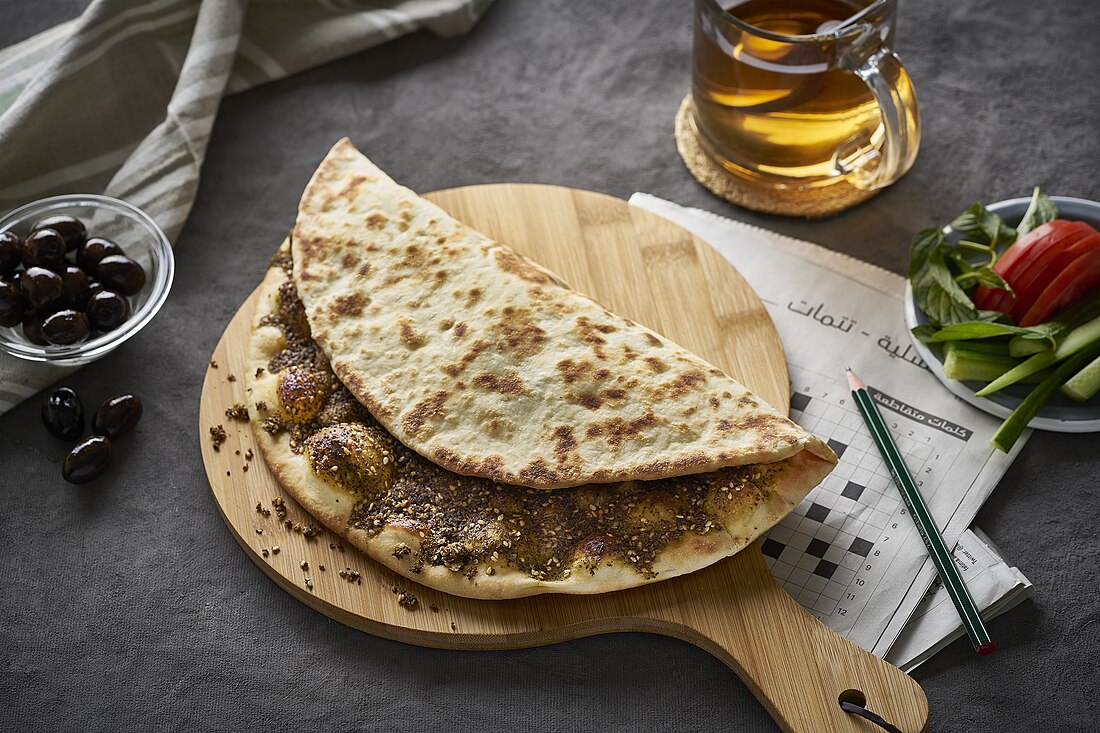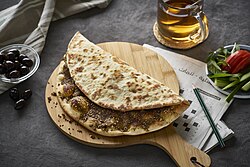Top Qs
Timeline
Chat
Perspective
Manakish
Levantine flatbread dish From Wikipedia, the free encyclopedia
Remove ads
Manakish (Levantine Arabic: مناقيش, romanized: manāʾīš; singular man'ousheh – منقوشة, manʾūše) is a popular Levantine pastry,[1] consisting of dough topped with za'atar (مناقيش بزعتر, manāʾīš bi-zaʿtar), cheese (مناقيش بجبنة, manāʾīš bi-jibne), or ground meat. It can be sliced or folded, and it can be served either for breakfast or lunch.[2]

Traditionally, women would bake dough in a communal oven in the morning to meet their family's daily bread needs, and would prepare smaller portions of dough with different toppings for breakfast at this time.[3] Saj and taboon are also common traditional cooking instruments for manakish.[4][5][6]
Manakish are popular across the Levant,[7][8] and can also be found in neighboring regions, and centers of Levantine emigration.
In 2023, manakish was inscribed to the UNESCO Intangible Cultural Heritage Lists as an emblematic culinary practice in Lebanon.[9]
Remove ads
Etymology
In standard Arabic, the word manāqīš is the plural of the word manqūšah, from the root verb naqaša (نقش), 'to sculpt, 'to carve out' or 'to engrave'; meaning that after the dough has been rolled flat, it is pressed by the fingertips to create little dips for the topping to lie in.[10]
History
Manakish is said to have originated in Phoenicia, where people would crush the wheat into flour with stone wheels to make bread.[11][12][better source needed]
An Arabic-language cookbook from the 10th century mentions recipes for flatbreads topped with za'atar and olive oil.[citation needed]
Classic toppings
This article needs additional citations for verification. (May 2023) |

- Za'atar (زَعْتَر, zaʿtar, 'thyme'). The most popular form of manakish uses za'atar (ground dried thyme, oregano, marjoram or some combination thereof, mixed with toasted sesame seeds, salt, and other spices such as sumac) as a topping.[13] The za'atar is mixed with olive oil and spread onto the dough before being baked in the oven. Za'atar manakish is a breakfast favorite in Levantine cuisine.[14][15] It is also served as part of a mezze, or as a snack with a glass of mint tea and feta cheese on the side.[14]
- Cheese (جُبْنَة, jibne). popular types of cheese used on manakish include: akkawi (عَكَّاوي, ʿakkawī)[16] and kashkaval (قَشْقَوَان, ʾašʾawān). Za'atar is occasionally added to cheese manakish to enhance its flavor.
- Lahmacun (لحم بعجين, laḥm bi-ʿajīn, 'meat with dough'), also called sfiha (صفيحة, ṣfīḥa). Manakish topped with minced lamb are served for lunch due to their heavier contents. The minced lamb is mixed with tiny pieces of diced tomato and oil, and the manakish is optionally served with ground pepper or pickles and yogurt.
- Chili (فليفلة, fulayfila, or فلفل حر, filfil ḥarr), or shatta sauce and onions, popular in the Gaza Strip.[17]
- Kashk (كشك). This is a mixture of fermented drained or dried yogurt and finely ground wheat that can be used by itself or in combination with other toppings, such as walnuts or onions, spread onto the bread.[18]
- Spinach (سبانخ, sbāniḫ), chard (سلق, silq).
- Eggs. Sometimes the bread has a ridge to prevent spilling, sometimes combined with cheese;[16][19] this may be called ikras beid or kras beid (اقراص بيض, iʾrāṣ bēḍ, 'egg discs').[20][21]
See also
- Feteer meshaltet
- Focaccia
- Khachapuri
- Lahmacun
- Musakhan
- Matnakash, a flat bread from Armenia. While the word may be related to manakish, matnakash is plain (no topping).
- Pita
- Pizza
- Iranian pizza
- Quesadilla
- Al-Maltout
References
Wikiwand - on
Seamless Wikipedia browsing. On steroids.
Remove ads

